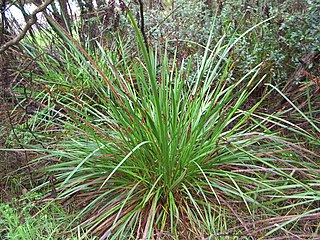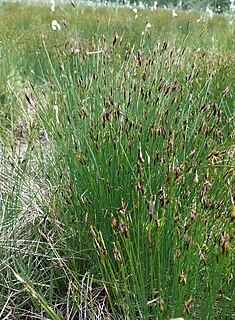
The Cyperaceae are a family of graminoid (grass-like), monocotyledonous flowering plants known as sedges. The family is large, with some 5,500 known species described in about 90 genera, the largest being the "true sedges" genus Carex with over 2,000 species.

Pogostemon is a large genus from the family Lamiaceae, first described as a genus in 1815. It is native to warmer parts of Asia, Africa, and Australia.

Osbeckia is a genus of plants in the family Melastomataceae. It was named by Carl Linnaeus for the Swedish explorer and naturalist Pehr Osbeck (1723–1805).

Cyanotis is a genus of mainly perennial plants in the family Commelinaceae, first described in 1825. It is native to Africa, southern Asia, and northern Australia.

Lepidosperma is a genus of flowering plant of the family Cyperaceae. Most of the species are endemic to Australia, with others native to southern China, southeast Asia, New Guinea, New Caledonia and New Zealand.

Schoenus is a predominately austral genus of sedges, commonly known as bogrushes, or veldrushes in South Africa. Species of this genus occur mainly in South Africa, Australia and Southeast Asia. Others are found in scattered locations worldwide, from Europe to Asia, North Africa and the Americas. Three species occur in the peatlands of southern South America, including S. antarcticus which is found in Tierra del Fuego, where it forms a component of hyperhumid Magellanic moorland.

Pollia is a genus of flowering plants in the Commelinaceae, first described in 1781. It is widespread through the Old World Tropics: Africa, southern Asia, northern Australia, etc. There is also one species endemic to Panama.

Elsholtzia is a plant genus in the Lamiaceae. It is widespread across much of temperate and tropical Asia from Siberia south to China, Northeastern India, Indonesia, etc. The genus was named in honour of the Prussian naturalist Johann Sigismund Elsholtz.
- Elsholtzia amurensisProb. - Amur region of Russia
- Elsholtzia angustifolia(Loes.) Kitag. - Korea, Manchuria
- Elsholtzia argyiH.Lév. - southern China, Vietnam
- Elsholtzia beddomeiC.B.Clarke ex Hook.f. - Myanmar, Thailand
- Elsholtzia blanda(Benth.) Benth. - southern China, Himalayas, Indochina, Sumatra, Viet Nam
- Elsholtzia bodinieriVaniot - Guizhou, Yunnan
- Elsholtzia byeonsanensisM.Kim - South Korea
- Elsholtzia capituligeraC.Y.Wu - Tibet, Sichuan, Yunnan
- Elsholtzia cephalanthaHand.-Mazz. - Sichuan
- Elsholtzia ciliata(Thunb.) Hyl. - widespread across Siberia, Russian Far East, China, India, Himalayas, Japan, Korea, Indochina
- Elsholtzia communis(Collett & Hemsl.) Diels - Myanmar, Thailand, Vietnam
- Elsholtzia concinnaVautier - Nepal, Sikkim, Bhutan
- Elsholtzia cyprianii(Pavol.) C.Y.Wu & S.Chow - central + southern China
- Elsholtzia densaBenth. - India, Pakistan, Nepal, Bhutan, Afghanistan, Kyrgyzstan, Tajikistan, Tibet, Xingjiang, China, Mongolia
- Elsholtzia eriocalyxC.Y.Wu & S.C.Huang - southern China
- Elsholtzia eriostachya(Benth.) Benth. - China, Tibet, Himalayas
- Elsholtzia feddeiH.Lév - China, Tibet
- Elsholtzia flavaBenth. - China, Himalayas
- Elsholtzia fruticosa(D.Don) Rehder - China, Himalayas, Tibet, Myanmar
- Elsholtzia glabraC.Y.Wu & S.C.Huang - China
- Elsholtzia griffithiiHook.f - Myanmar, Assam
- Elsholtzia hallasanensisY.N.Lee - Jeju-do Island in Korea
- Elsholtzia heterophyllaDiels - Yunnan, Myanmar
- Elsholtzia hunanensisHand.-Mazz. - southern China
- Elsholtzia kachinensisPrain - southern China, Myanmar, Thailand
- Elsholtzia litangensisC.X.Pu & W.Y.Chen - Sichuan
- Elsholtzia luteolaDiels - Sichuan, Yunnan
- Elsholtzia minimaNakai - Jeju-do Island in Korea
- Elsholtzia myosurusDunn - Sichuan, Yunnan
- Elsholtzia nipponicaOhwi - Japan
- Elsholtzia ochroleucaDunn - Sichuan, Yunnan
- Elsholtzia oldhamiiHemsl. - Taiwan
- Elsholtzia pendulifloraW.W.Sm - Yunnan, Thailand, Vietnam
- Elsholtzia pilosa(Benth.) Benth. - China, Himalayas, Myanmar, Vietnam
- Elsholtzia pubescensBenth. - Java, Bali, Lombok, Timor, Sulawesi
- Elsholtzia pygmaeaW.W.Sm. - Yunnan
- Elsholtzia rugulosaHemsl - southern China, Myanmar, Thailand
- Elsholtzia serotinaKom - northern China, Japan, Korea, Primorye
- Elsholtzia soulieiH.Lév. - Sichuan, Yunnan
- Elsholtzia splendensNakai ex F.Maek. - China, Korea
- Elsholtzia stachyodes(Link) Raizada & H.O.Saxena - Indian Subcontinent, China, Myanmar
- Elsholtzia stauntoniiBenth. - northern China
- Elsholtzia strobilifera(Benth.) Benth. - China, Himalayas, Myanmar
- Elsholtzia winitianaCraib - Yunnan, Guangxi, Laos, Thailand, Vietnam

Machaerina (twigrush) is a genus of flowering plants in the sedge family. Its species occur in tropical America, the West Indies, Malesia, Australia and the Pacific region. The name comes from the Greek machaira, alluding to the shape of the leaves in the type species – Machaerina restioides.

Erigeron multiradiatus is an Asian species of flowering plants in the daisy family known by the common name Himalayan fleabane. It grows at high elevations in the mountains of central and south-central Asia, in Iran, Afghanistan, Bhutan, India, Kashmir, Nepal, and China.
Stauranthera is a genus of flowering plants in the family Gesneriaceae, native to Bangladesh, the Nicobar Islands, Assam, the eastern Himalayas, south-central and southeast China, Southeast Asia, and Malesia to New Guinea. It is very close morphologically and genetically to Loxonia.
Actinocarya is a small genus of annual herbs in the family Boraginaceae. Species in the genus are found in Pakistan, China, and India.
Pleurospermum is a genus of flowering plants belonging to the family Apiaceae.
Dischistocalyx is a genus of flowering plants belonging to the family Acanthaceae.
Pandiaka is a genus of flowering plants belonging to the family Amaranthaceae.
Phaulopsis is a genus of flowering plants belonging to the family Acanthaceae.
Phialacanthus is a genus of flowering plants belonging to the family Acanthaceae.
Rostellularia is a genus of flowering plants belonging to the family Acanthaceae.
Herpetospermum is a genus of flowering plants belonging to the family Cucurbitaceae.
Microula is a genus of flowering plants belonging to the family Boraginaceae.









